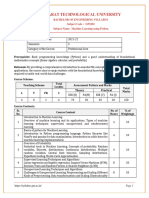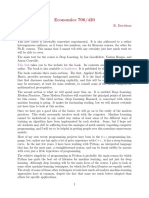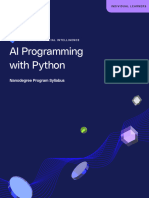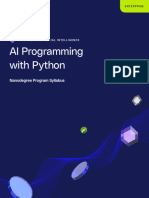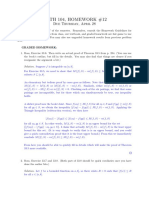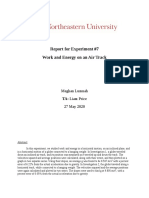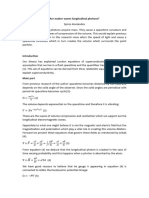Course Admin
EE-UY 4563/EL-GY 6123: INTRODUCTION TO MACHINE LEARNING
PROF. SUNDEEP RANGAN
1
�People
Professor: Sundeep Rangan, srangan@nyu.edu
◦ 2 MetroTech Center 9.104
◦ Office Hours: Thursdays, 2-4pm
Head TAs:
◦ Juntao Chen jc6412@nyu.edu
◦ Amirhossein Khalilian-Gourtani akg404@nyu.edu
◦ Office Hours: TBD
◦ Ask for all questions regarding homeworks and labs
There will be several other graders as well
2
�Course Learning Objectives
Formulate a task as a machine learning problem
◦ Identify learning objectives, source of data, models, …
Load, pre-process and extract features from common data sources
◦ images, text, audio, …
Mathematically describe simple models of the data
Fit the models to data and use models for prediction and estimation
◦ Use common tools
Evaluate goodness of fit and refine models
Evaluate the performance of methods using statistical techniques
3
�Grad vs Undergrad
Class is simultaneously offered at the graduate and undergraduate level
Undergrad EE-UY/CSE-UY 4563: Intro to Machine Learning
◦ Covers fundamental algorithms and some analysis
◦ In depth coverage of software tools including python, Google Cloud, Tensorflow
◦ Python-based lab exercises + mandatory project
Grad EL 6123: Intro to Machine Learning
◦ More algorithms and more mathematical analysis. Faster paced.
◦ Software tools must be learned at home. Less coverage in class
◦ Python-based lab exercises + optional project
Lecture notes are mostly common with supplementary material for grad students indicated
Many labs are common
4
�Texts and Other Resources
Undergrad: James, Witten, Hastie and Tibshirani, “An Introduction to Statistical Learning”,
◦ http://www-bcf.usc.edu/~gareth/ISL/ISLR%20First%20Printing.pdf
◦ Very clear explanation of concepts.
◦ But examples are in R. And there is no review of probability
Grad: Hastie, Tibshirani, Friedman, “Elements of Statistical Learning”
◦ https://web.stanford.edu/~hastie/Papers/ESLII.pdf
◦ More advanced text with more analysis
Raschka, “Python Machine Learning”, 2015.
◦ http://file.allitebooks.com/20151017/Python%20Machine%20Learning.pdf
◦ Excellent examples of using Python
Bishop, “Pattern Recognition and Machine Learning” (more advanced)
Coursera course: Generally do not cover probability
Undergrad probability
5
�More Resources
Entertaining and very good deep learning lectures by Siraj Raval
◦ https://www.youtube.com/channel/UCWN3xxRkmTPmbKwht9FuE5A
Universite de Paris labs:
◦ https://github.com/m2dsupsdlclass/lectures-labs
◦ Focus on deep learning
◦ Similar format to this class
Andrew Ng’s machine learning class:
◦ https://www.coursera.org/learn/machine-learning
◦ A little less mathematical than this class
Many, many others online…
6
�Pre-Requisites
Undergrad probability required for both UG and Grad version:
◦ Basics of random variables, densities, Gaussian distributions, correlation, expectation,
conditional densities, Bayes’ theorem
◦ Will provide a short review
◦ NYU classes: Data analysis or Intro Probability are sufficient
Undergraduate calculus and linear algebra
◦ Vectors, matrices, partial derivatives, gradients.
◦ Again, we will provide a brief review
No machine learning experience is necessary
◦ If you have ML experience, do NOT take this class.
◦ Take Graduate probability (Fall) then Advanced machine learning (Spring)
7
�Pre-Requisites Programming
Python
◦ All labs are in python, similar to object-oriented MATLAB, but many more libraries.
◦ And free!
What you need to know
◦ You do not need to know python before class. But, we will go over it quickly.
◦ You should have experience in some programming language (eg. MATLAB).
◦ You should know or being willing to learn object oriented programming
Resources:
◦ Installing python and ipython notebook (make sure you install Version 3.6)
http://jupyter-notebook-beginner-guide.readthedocs.io/en/latest/index.html
◦ Python tutorial: https://docs.python.org/3/tutorial/
◦ Numpy: http://cs231n.github.io/python-numpy-tutorial/
8
�Grading: Undergraduate
Midterm 1: 25%, Midterm 2: 25%, Labs, HW: 25%, Final project: 25%
Labs: Simple python exercises
◦ Given as jupyter notebook that you complete.
Midterms
◦ Each over approx. 3-4 weeks of material
◦ Closed book with cheat sheet.
◦ Follows homework and quiz problems + some very basic python questions
Final project:
◦ Use machine learning in some interesting way.
◦ Must use data and python analysis.
◦ Provide final report.
9
�Grading: Graduate
Midterm 35%, Final 35%, Labs / HW 30%
◦ Optional project: Up to 20%
Labs: Simple python exercises
◦ Given as jupyter notebook that you complete.
Midterms & final
◦ Each over approx. 6-7 weeks
◦ Open book but no electronic aids.
◦ Follows homework and quiz problems + some very basic python questions
Optional final project:
◦ Use machine learning in some interesting way.
◦ Must use data and python analysis.
◦ Provide final report.
10
�Machine Learning Project
Perform an interesting machine learning task of your choice
Many possible areas:
◦ Machine vision, brain-computer interfaces, natural language processing, sentiment analysis, …
◦ Anything that interests you
Groups of 2 preferred
◦ In NYU Classes, join a group “project1, project2, …”
◦ Submit all material as that group
Use real data
◦ UCI ML repository
◦ Google BigQuery data
Write code
Place all material in a github repo (including documentation) and submit only github repo
11
�Project Grading
Formulation
◦ How well did you formulate the problem? Was it clear? Was that tied to the right objective?
Approach
◦ Does your approach properly solve your problem? Was that made clear?
Evaluation and Interpretation
◦ Did you comprehensively test the results? How well did you select / create the data?
◦ Did you test against alternative approaches?
Presentation
◦ Were the ideas clear? Were all the details conveyed. Did you highlight the main points?
◦ You can select a number of formats. Whatever makes sense. A github page
Bonus
◦ Given for particularly hard / novel research
12
�Github
Labs and demo posted on github
https://github.com/sdrangan/introml/
Also includes instruction for installing software
Several tutorials of github on the web.
Available on Windows, Mac and Unix.
But, you can just clone the repo
13
�Google Cloud Platform
All labs in this class can be run on either:
◦ Your own computer: Windows, MAC
◦ Google Cloud Platform (GCP)
GCP pros and cons:
◦ Access to powerful machines / large storage for projects.
Includes GPUs
◦ Access to many services such as BigQuery
◦ Can scale your computational resources
◦ But, somewhat harder to sync editors / debuggers
Getting started: https://cloud.google.com/
Instructions on
https://github.com/sdrangan/introml/tree/master/GCP
14
�Other Software
On your machine (local or GCP), you will need to install several pieces of software:
Python with various packages
◦ Make sure you get 3.6
◦ Anaconda
◦ Jupyter notebook
◦ See notes in NYU Classes
Tensorflow and Keras (needed only later in the class)
Git hub
◦ Guides: https://guides.github.com/
◦ Available on Windows, Mac or Linux (including GCP instances)
◦ All demos will be available on: https://github.com/sdrangan/introml.git
15


